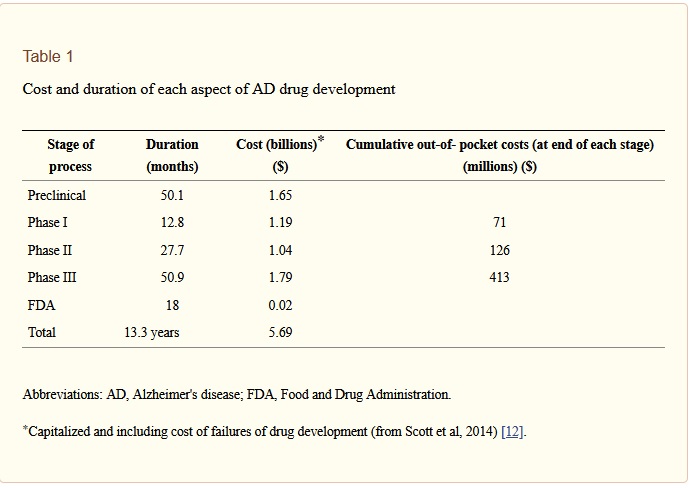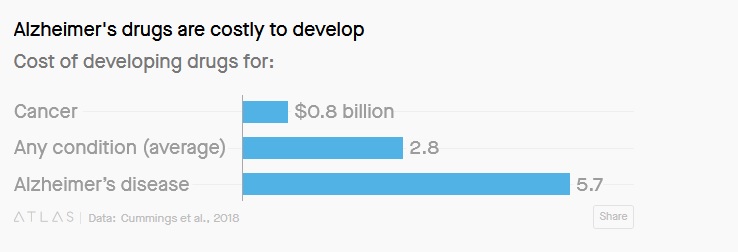(Total Views: 9021)
Posted On: 12/11/2019 1:31:14 PM
Post# of 157749
Continuing with the brain diseases, from Aug 19
Very very good read including a review of studies done that have both shown a link with ccr5 and studies that shown no casual difference in ccr5 delta 32 group. Why is that?
Also talks about recent developments with ccr5 with cancer, etc.
Entanglement of CCR5 and Alzheimer’s Disease
https://www.frontiersin.org/articles/10.3389/...00209/full
Also interesting the price of AD drugs, very expensive compared to cancer. 13 years, 5B dollars. I wonder what for NASH, explains why companies are more willing to jump in at phase 2, save a ton of money and time.
https://www.ncbi.nlm.nih.gov/pmc/articles/PMC6118094/

Also why cancer is more popular: cheaper, faster, and smaller bar to jump over.
https://qz.com/1627744/alzheimers-drugs-cost-...o-develop/

Very very good read including a review of studies done that have both shown a link with ccr5 and studies that shown no casual difference in ccr5 delta 32 group. Why is that?
Also talks about recent developments with ccr5 with cancer, etc.
Entanglement of CCR5 and Alzheimer’s Disease
https://www.frontiersin.org/articles/10.3389/...00209/full
Quote:
The definite mechanism of AD remains unclear, but our understanding of AD has far exceeded the two typical pathological manifestations—Aβ and tau. The neuroinflammation theory of AD is fascinating an increasing number of researchers. Currently, more than 5000 studies about AD and neuroinflammation are available on PubMed, and the number is expanding. CCR5 expression was strongly related to microglia and inflammation, which validated an inseparable relationship between inflammation, Alzheimer’s disease, and CCR5 (Andreassen et al., 2018). As the most notable receptor among the chemokine receptor family, the accurate function and subsequent signaling pathways of CCR5 have been well studied. Available epidemiological evidence could provide no connection between the CCR5Δ32 gene and AD (Onofre et al., 2004; Salvador et al., 2004; Balistreri et al., 2006). However, given that all of the epidemiological evidence was based on genotype and performed more than a decade ago, potential links may lie deeper than the superficial genotype, such as translational modulation, proteomics, and epigenetics. Despite the controversy, it cannot be denied that CCR5 plays an important role in the process of LTP, cortical plasticity, learning and memory (Cai et al., 2016). We posited that the reason for experimental conflicts between CCR5 and AD are as follows: the animal models and the methods the authors used for acquiring AD models were varied. Furthermore, compared with administration of small interfering RNA (siRNA), maraviroc and other antagonists, the effect of total knockout of the CCR5 gene could lead to an enormous impact on cellular signal pathways inside the membrane. Further investigation should take these factors into account . Future studies of molecular mechanisms of subsequent intracellular signal pathways caused by CCR5 activation would shed new light on this entanglement between AD and CCR5.
Also interesting the price of AD drugs, very expensive compared to cancer. 13 years, 5B dollars. I wonder what for NASH, explains why companies are more willing to jump in at phase 2, save a ton of money and time.
https://www.ncbi.nlm.nih.gov/pmc/articles/PMC6118094/

Also why cancer is more popular: cheaper, faster, and smaller bar to jump over.
https://qz.com/1627744/alzheimers-drugs-cost-...o-develop/

Quote:
In addition to the difficulty of finding suitable participants for Alzheimer’s research, clinical trials take years because the condition progresses very slowly. The authors of the above paper estimate that it takes over 13 years to put a drug through all of the clinical trials required for approval from the US Food and Drug Administration. The Pharmaceutical Research and Manufacturers of America, a trade group that lobbies for pharmaceutical companies, estimates that this process takes about a decade (pdf) for other drugs on average.
Cancer drugs, on the other hand, have been found to take significantly fewer resources and less time than other kinds of drugs to develop. They have far shorter clinical trials where success is measured by increased survival rates, and often piggyback off existing therapies to make incremental improvements.

